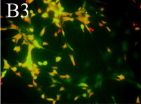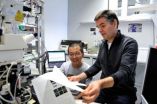(Press-News.org) This news release is available in German.
If you put your hand over a switched-on torch in the dark, it appears to glow red. This is because long-wavelength red light beams penetrate human tissue more effectively than short-wavelength blue light. ETH Zurich researchers exploit this fact in a new kind of nanoparticles: so-called plasmonic particles, which heat up when they absorb near-infrared light. This could enable them to kill tumour tissue with heat, for instance.
Gold is a popular material for nanoparticles used therapeutically, as it is well tolerated and does not usually trigger any undesirable reactions. In the characteristic ball or sphere shape of nanoparticles, however, gold does not have the necessary properties to work as a plasmonic particle that absorbs sufficiently in the near-infrared spectrum of light to heat up. To do so, it needs to be moulded into a special shape, such as a rod or shell, so that the gold atoms adopt a configuration that starts absorbing near-infrared light, thereby generating heat. Producing such nanorods or nanoshells in sufficient amounts, however, is complex and expensive.
Aggregates instead of rods
A team of researchers headed by Sotiris Pratsinis, Professor of Particle Technology at ETH Zurich, has now discovered a trick to manufacture plasmonic gold particles in large amounts. They used their existing know-how on plasmonic nanoparticles (see also: http://www.ethlife.ethz.ch/archive_articles/110512_Plasmonischer_biosensor_su/index_EN) and made sphere-shaped gold nanoparticles that display the desired near-infrared plasmonic properties by allowing them to be aggregated. Each particle is coated with a silicon dioxide layer beforehand, which acts as a placeholder between the individual spheres in the aggregate. Through the precisely defined distance between several gold particles, the researchers transform the particles into a configuration that absorbs near-infrared light and thus generates heat.
"The silicon dioxide shell has another advantage", explains Georgios Sotiriou, first author on the study and, until recently, a postdoc in Pratsinis' research group and currently an Swiss National Science Foundation Fellow at Harvard University: "It prevents the particles from deforming when they heat up." This is a major problem with nanorods. If the rods lose their shape while heating up, they lose their desired plasmonic properties and are no longer able to absorb enough near-infrared light to generate heat.
The researchers have already tested the new particles on breast cancer cells in a Petri dish and discovered that after exposure to near-infrared light the nanoparticles heated up sufficiently to kill off the cells, while cells survived in control experiments (with particles but without radiation and with radiation but without nanoparticles).
Combination with great potential
To be able to steer the particles specifically towards cancer tissue, the researchers also mixed superparamagnetic iron oxide particles in with the gold particles, which enable the nanoaggregates to be controlled via magnetic fields and may enhance their accumulation in a tumour. Moreover, this opens up the possibility of heating the aggregates in deep layers of tissue that infrared light can no longer reach via magnetic hyperthermia. Here, the heating of the particles is induced by a magnetic field, where the plus and minus poles alternate at a rapid rate.
"A lot of questions still need to be answered before the particles can be used in humans", says Jean-Christophe Leroux, Professor of Drug Formulation and Delivery at ETH Zurich, who was also involved in the research project. Although gold, silicon dioxide and iron oxide are well tolerated, what happens to the particle aggregates in the body in the course of time – whether they accumulate in the liver or are broken down and excreted, for instance – still needs to be investigated.
The hybrid iron oxide-gold nanoparticles are not only able to kill off tumour cells through heat; they could also be used as a contrast medium for imaging processes in diagnostics by magnetic resonance imaging, as investigated in collaboration with University Hospital Zurich, or as part of a vehicle that carries active substances. "You could even couple the particles with temperature-responsive drug carriers, which would then allow the drug release if a certain temperature were exceeded", explains Sotiriou. This would allow undesirable side effects on the rest of the body to be reduced or even avoided.
INFORMATION:
Further reading:
Sotiriou GA, Starsich F, Dasargyri A, Wurnig MC, Krumeich F, Boss A, Leroux JC, Pratsinis SE: Photothermal Killing of Cancer Cells by the Controlled Plasmonic Coupling of Silica-Coated Au/Fe2O3 Nanoaggregates. Adv. Funct. Mater., 13 January, 2014. DOI: 10.1002/adfm.201303416
Hot nanoparticles for cancer treatments
2014-03-24
ELSE PRESS RELEASES FROM THIS DATE:
Nature Immunology study finds novel population of neutrophils
2014-03-24
Case Western Reserve University researchers have discovered a novel population of neutrophils, which are the body's infection control workhorses. These cells have an enhanced microbial killing ability and are thereby better able to control infection.
Neutrophils, the body's most abundant type of white blood cells, have long been regarded as first responders that kill fungi, bacteria, and other pathogens. In a study published in the February issue of Nature Immunology, Case Western Reserve researchers explain that they have found the mechanism of action of a newly discovered ...
GDNF transfection promotes neuronal differentiation of bone marrow mesenchymal stem cells
2014-03-24
Studies have shown that the differentiation rate of grafted bone marrow mesenchymal stem cells into mature neuron-like cells is very low. Therefore, it is very important to establish an effcient and stable induction protocol to promote the differentiation of bone marrow mesenchymal stem cells into neuron-like cells in vitro and elucidate the mechanisms underlying differentiation for the treatment of central nervous system diseases. Jie Du and colleagues from Sichuan University in China found that glial cell line-derived neurotrophic factor/bone marrow mesenchymal stem cells ...
Electroacupuncture effect on depression and variation of polygenes expression
2014-03-24
Preliminary basic research and clinical findings have demonstrated that electroacupuncture therapy exhibits positive effects in ameliorating depression. However, most studies of the underlying mechanism are at the single gene level; there are few reports regarding the mechanism at the whole-genome level. Using a rat genomic gene-chip, Dr. Dongmei Duan and co-workers from General PLA Hospital in China profiled hippocampal gene expression changes in rats after electroacupuncture therapy. Electroacupuncture therapy alleviated depression-related manifestations in the model ...
Tecnalia presents a smart home able to detect symptoms of neurodegenerative diseases
2014-03-24
The world population is rapidly ageing, which means the number of disabled and dependent people is increasing since these rates increase with age, particularly after the age of 80. This is the context in which the Tecnalia centre for applied research has designed a system of sensors which when fitted in a home, allows a person's habits and activities to be monitored and any changes in his/her habits and activities that could be a symptom of disorders relating to neurodegenerative diseases like Alzheimer's to be detected.
Since the symptoms of diseases like Alzheimer's ...
'MaMTH' advance: New technology sheds light on protein interactions
2014-03-24
TORONTO — Scientists have a better way to study human proteins — large molecules that are part of every cell in the body — thanks to a new technology developed by University of Toronto researchers. The technology tracks a class of proteins called membrane proteins as they interact with other proteins to either maintain health or contribute to disease.
Membrane proteins make up about one third of all proteins in the human body, and their malfunction is associated with more than 500 diseases. But they've been hard to study because understanding their role depends on observing ...
Experiment opens the door to multi-party quantum communication
2014-03-24
In the world of quantum science, Alice and Bob have been talking to one another for years. Charlie joined the conversation a few years ago, but now with spacelike separation, scientists have measured that their communication occurs faster than the speed of light.
For the first time, physicists at the Institute for Quantum Computing (IQC) at the University of Waterloo have demonstrated the distribution of three entangled photons at three different locations (Alice, Bob and Charlie) several hundreds of metres apart, proving quantum nonlocality for more than two entangled ...
Fast and reliable: New mechanism for speedy transmission in basket cells discovered
2014-03-24
This news release is available in German.
In his third major research paper since December 2013, IST Austria Professor Peter Jonas together with his collaborator, postdoc Hua Hu, identifies a new subcellular mechanism for reliable, fast transmission in the so-called basket cells of the brain. The results will be published on the website of Nature Neuroscience on March 23, 2014 (DOI 10.1038/nn.3678)
IST Austria president Thomas Henzinger expressed his delight: "This is an extraordinary streak of publications in major journals which once more emphasizes the outstanding ...
Heparin might be the key to prevent prion conversion and disease
2014-03-24
Prions are infectious agents responsible for neurodegenerative diseases such as bovine spongiform encephalitis (commonly known as "mad cow disease") and Creutzfeldt–Jakob disease in humans.
Since the discovery in the 60s that an incurable and fatal disease could be caused by an infectious agent formed by nothing but converted misfolded proteins, the mechanisms responsible for the conversion of a normal prion protein into its infectious counterpart – the scrapie prion – have been relentlessly investigated. Researchers now know that once converted into the scrapie form, ...
p53 cuts off invading cancer cells
2014-03-24
VIDEO:
In the absence of Omi, Ras-transformed tumor cells form invasive lamellipodial protrusions.
Click here for more information.
The tumor suppressor p53 does all it can to prevent oncogenes from transforming normal cells into tumor cells by killing defective cells or causing them to become inactive. Sometimes oncogenes manage to initiate tumor development in the presence of p53, but, even then, the tumor suppressor doesn't give up and focuses its efforts instead on limiting ...
How developing sperm stick to the right path
2014-03-24
The process of producing high-quality, fertile sperm requires many steps. A study in The Journal of Cell Biology shows how the transcription factor p73 promotes this process by regulating the adhesions between developing sperm and their support cells.
The p53 family of transcription factors has an ancient and well-conserved function in protecting reproductive cells. In mammals, for example, p63 promotes the death of eggs and sperm that have sustained DNA damage, and female mice lacking p73 are infertile due to defects in egg development. Male mice lacking p73 are also ...




